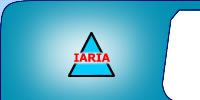

 |
The Second International Conference on Access Networks ACCESS 2011 June 19-24, 2011 - Luxembourg |
| Call for Papers |
High competitive business models for offering applications demanding interactivity, unlimited access, and full-scale media support lead to deployment of new access technologies. In spite of the exponential growth of IP traffic, there is stagnation in broadband penetration due both to the lack of suitable access infrastructures and to the lack of significant demand (large enough to motivate the investments). The prevailing access model, based on vertical integration (for operators) and on flat-fee prices (for users), is often inadequate to overcome the stagnation and to encourage investments and innovation.
ACCESS 2011 continues a series of conferences dealing with access networks, services and technologies based on the previous NEUTRAL and HOWAN workshop treating particular access aspects. ACCESS 2011 aims to provide an international forum by researchers, students, and professionals for presenting recent research results on advances in networking access, including the newest emerging access technologies, broadband access, wireless access, copper access, optical access, mobility aspects, as well as optical/wireless combination and neutrality.
Hybrid Optical and Wireless Access Networks (HOWANs) consists of a multi-hop wireless mesh network (WMN) at the front-end and an optical access network, e.g., a passive optical network (PON) at the back-end. PONs use inexpensive and passive optical splitters to divide a single fiber into separate strands feeding individual subscribers. EPON is based on the Ethernet standard, which comes with the added benefit of the economies-of-scale of Ethernet, and provides simple and easy-to-manage connectivity both at the customer premises and at the central office.
Granting positive externalities to the shared access infrastructure in order to enhance digital inclusion and broadband penetration by triggering a positive feedback loop among users, service providers, network operators, and investors is an option. The access infrastructure can be considered as a network per see, called "neutral access network" (NAN), which provides internal services and possibly exploits its territorial dimension in order to overcome the dichotomy between "on-line" and "off-line" people. While in a traditional access network, people who are not registered with any ISP are left out from the so called "information society", NANs can provide an intermediate area, which is logically placed "before the Internet", where on-line services and applications can be made available to residential and nomadic users who are not yet registered with any ISP.
We welcome technical papers presenting research and practical results, position papers addressing the pros and cons of specific proposals, such as those being discussed in the standard fora or in industry consortia, survey papers addressing the key problems and solutions on any of the above topics short papers on work in progress, and panel proposals.
Industrial presentations are not subject to the format and content constraints of regular submissions. We expect short and long presentations that express industrial position and status.
Tutorials on specific related topics and panels on challenging areas are encouraged.
The topics suggested by the conference can be discussed in term of concepts, state of the art, research, standards, implementations, running experiments, applications, and industrial case studies. Authors are invited to submit complete unpublished papers, which are not under review in any other conference or journal in the following, but not limited to, topic areas.
All tracks are open to both research and industry contributions.
NEXTACCESS: Next generation access technologies
Interactivity, unlimited access and full-scale media support
Energy-aware and efficiency-oriented technologies
Sustainable access network business (standard DSL vs. fiber vs. wireless access)
3G/4G wireless technologies
Multiservice access (DSL, fiber, WiMAX, POTS)
FTTH
Ethernet P2P vs. xPON
FTTx with VDSL2, or Ethernet, or DOCSIS 3.0
Radio extension, 802.xx (Wi-Fi, WiMax, etc.)
LTE, LTE-advanced
IMT-advanced networks
Mesh and relay networks (IEEE 802.11s, IEEE802.16j, etc.)
Quality of experience (QoE)
FEMTO: Femtocells-based access
Femtocells architectures
Femtocells requirements ands specifications
Femtocells protocols
Femtocells services and applications
Traffic and QoS in Femtocells
Performance analysis in Femtocells
Femtocells control and management
Interoperability of Femtocells devices
Femtocells operation optimization
Femtocells specific solutions for mobility
OFDMA Femtocells: interference avoidance
Macrocell-Femto cell interference issues and mitigation
Macrocell-Femto cell handover strategies
WiMAX Fentocells
Standardization of Femtocells
BROADBAND: Broadband wireless Internet access
New architectures, technologies, protocols for broadband wireless access
QoS in mobile and broadband wireless access networks
Broadcast and multicast support
Physical and data link layer issues
Medium access control, SLA and QoS
Radio resource management and call admission control
Space-time coding for broadband wireless Internet
Modulation, coding and antennas (MIMO)
Spectrum management
Scalability and reliability issues
Wireless mesh networks
Capacity planning and traffic engineering
Security and privacy issues
Interoperability aspects (fixed/mobile LANs/MANs, WANs)
Experiences/lessons from recent deployments
OPTICAL: Optical access networks
Optical access network architecture design
Optical access network components and systems
New PON developments and testbeds
WDM and OFDM PON technologies
MAC and bandwidth allocation
RoF network architecture and MAC
RoF components and systems
Signal processing for new modulation formats
Optical spectral management
Multimode fiber technology and applications
Performance monitoring and diagnosis
Deployment and economic analysis
MOBILE WIRELESS: Mobile wireless access
Mobile Broadband Wireless Access
Wireless/Mobile Access Protocols
Wireless/Mobile Web Access
Ubiquitous and mobile access
Mobile/vehicular environment access
Multi-Homing and Vertical Handoff
Localization and tracking
Context-aware services and applications
Context-aware protocols and protocol architectures
Interactive applications
Mobile and Wireless Entertainment
Mobile Info-services
Wireless ad hoc and sensor networks
DYNAMIC: Dynamic and cognitive access
Dynamic spectrum access
Architectures and platforms for dynamic spectrum access networks
Spectrum sensing, measurement and models
Efficient and broadband spectrum sensing
Interference metrics and measurements
New spectrum protocols and models
Cognitive radio (cross-layer optimization)
Multiple access schemes for cognitive radio networks
Radio resource management and dynamic spectrum access networks
Dynamic spectrum auction and economics
Business model, pricing, and regulations for dynamic spectrum
HOWAN: Hybrid optical and wireless access networks
Multi-hop wireless mesh networks
Passive optical networks
Node architecture and design of hybrid optical and wireless networks
Emerging wireless/optical applications QoS management for hybrid access networks
PON and WDM-PON network experiments
Radio over Fiber (RoF)
FTTx network architecture and applications
Routing and multicast over hybrid optical and wireless networks
Service resilience and availability of hybrid optical and wireless networks
Applications and evolutions of hybrid access networks
Network design, control, and performance in HOWANs
Capacity analysis, flow and congestion control in HOWANs
Optimization of hybrid optical and wireless networks
Evolution of HOWAN access networks Broadband wireless access in HOWANs
Security and privacy in HOWANs
New services and applications
Test-bed and prototype implementation
Standardization issues
COPPER: Copper Access
Ubiquity via phone lines
Speed reaching 100 Mbps
DSL broadband access
Dynamic and joint optimization of resources (frequency, amplitude, space, and time)
Attenuation and crosstalk bottlenecks
Management and control for the multi-user twisted pair networks
GIGATERA: Giga/Tera Access
Multi-antenna technologies (MIMO, Beamforming, Antenna Selection, etc)
RF/Antenna propagation (RF beamforming, Tera-Hz signal generation, Propagation)
Interoperability aspects (fixed/mobile LANs/MANs, WANs)
Signal processing for millimeter and Tera-Hz wireless systems
NLOS avoidance techniques
Cooperative networks, repeaters and relaying
Error correction, equalization
Space division multiple access
Coexistence and interoperability
OFDM versus single-carrier systems
MIMO in mm-wave and Tera-Hz systems
OFDMA processing
Spread spectrum techniques
High-efficiency medium access control (MAC) protocol
Neighbor discovery in directional wireless networks
CONTROL: Access Control
Foundations for access control
Models for access control
Mechanisms for access control
Policy-driven and role-driven access control
Delegation and identity management
Privacy-drive control
Access control for advanced applications (cloud, autonomic, sensor, social networks, etc.)
Standards for accesses control
NEUTRAL: Neutral Access Networks
Open access networks
Network neutrality
Operator-neutral residential access technologies
Operator-neutral nomadic access technologies
Operator-neutral mobile access technologies
Operator-neutral CPEs
Internet access regulation
NANs design and management
Multi-gateway traffic management
QoS management in shared infrastructures
Routing and multicast in NANs
Broadband business models for NANs
Broadband pricing models for NANs
Broadband market analysis for NANs
IP traffic models for NANs
Edge routers for NANs
Identity management in NANs
NANS and Digital divide
NANs and Digital inclusion
Inclusive services and applications
NAN testbeds and case studies
LEGAL: Legal aspects on network and service access
Network neutrality principle
Security and privacy rights
Institutional implications
Accessibility and social affordability
User responsibility
INSTRUCTION FOR THE AUTHORS
Authors of selected papers will be invited to submit extended versions to one of the IARIA Journals.
Publisher: XPS (Xpert Publishing Services)
Archived: ThinkMindTM Digital Library (free access)
Prints available at Curran Associates, Inc.
Articles will be submitted to appropriate indexes.
Important deadlines:
Due to numerous requests, submissions are accepted until March 5, 2011| Submission (full paper) | |
| Notification | |
| Registration | |
| Camera ready | April 20, 2011 |
Only .pdf or .doc files will be accepted for paper submission. All received papers will be acknowledged via an automated system.
Final author manuscripts will be 8.5" x 11", not exceeding 6 pages; max 4 extra pages allowed at additional cost. The formatting instructions can be found on the Instructions page. Helpful information for paper formatting can be found on the here.
Your paper should also comply with the additional editorial rules.
Once you receive the notification of paper acceptance, you will be provided by the publisher an online author kit with all the steps an author needs to follow to submit the final version. The author kits URL will be included in the letter of acceptance.
Posters
Posters are welcome. Please submit the contributions following the instructions for the regular submissions using the "Submit a Paper" button and selecting the contribution type as poster. Submissions are expected to be 6-8 slide deck. Posters will not be published in the Proceedings. One poster with all the slides together should be used for discussions. Presenters will be allocated a space where they can display the slides and discuss in an informal manner. The poster slide decks will be posted on the IARIA site.
For more details, see the Posters explanation page.
Work in Progress
Work-in-progress contributions are welcome. Please submit the contributions following the instructions for the regular submissions using the "Submit a Paper" button and selecting the contribution type as work in progress. Authors should submit a four-page (maximum) text manuscript in IEEE double-column format including the authors' names, affiliations, email contacts. Contributors must follow the conference deadlines, describing early research and novel skeleton ideas in the areas of the conference topics. The work will be published in the conference proceedings.
For more details, see the Work in Progress explanation page
Technical marketing/business/positioning presentations
The conference initiates a series of business, technical marketing, and positioning presentations on the same topics. Speakers must submit a 10-12 slide deck presentations with substantial notes accompanying the slides, in the .ppt format (.pdf-ed). The slide deck will not be published in the conference’s CD Proceedings. Presentations' slide decks will be posted on the IARIA's site. Please send your presentations to [email protected].
Tutorials
Tutorials provide overviews of current high interest topics. Proposals should be for three hour tutorials. Proposals must contain the title, the summary of the content, and the biography of the presenter(s). The tutorials' slide decks will be posted on the IARIA's site. Please send your proposals to [email protected]
Panel proposals:
The organizers encourage scientists and industry leaders to organize dedicated panels dealing with controversial and challenging topics and paradigms. Panel moderators are asked to identify their guests and manage that their appropriate talk supports timely reach our deadlines. Moderators must specifically submit an official proposal, indicating their background, panelist names, their affiliation, the topic of the panel, as well as short biographies. The panel's slide deck will be posted on the IARIA's site.
For more information, [email protected]
Workshop proposals
We welcome workshop proposals on issues complementary to the topics of this conference. Your requests should be forwarded to [email protected].